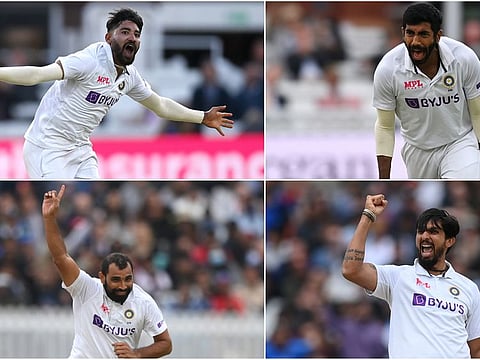Lord’s Test win: Is this India’s best-ever phase of fast bowling yet?
Sheer variety and ability to strike fear in batsmen’s hearts makes Bumrah & Co the best

Kolkata: Test cricket, as it showed once more during India’s dominant win over England at the Lord’s Test, can make a mockery of the pundits. Even till the third day of the match, experts were pontificating if Ravi Ashwin would be missed on a wearing fourth or fifth day as England would be batting last in the game.
At least a couple of them said they didn’t see India winning the match after fourth day’s play as they looked capable of cobbling together a target of 180-plus at best - and with India missing their main spinner to keep the pressure on - there were two possible results of either England going ahead in the series or a draw. The pace quartet of Jasprit Bumrah, Mohammed Shami, Mohammed Siraj and Ishant Sharma had other ideas - though not many of the diehard Indian fans could imagine that it could be with their bats as well.
The twist in the tale Shami and Bumrah provided with a counter-attacking, unbeaten ninth wicket stand of 89 put the pressure back on England - though it was again being debated if the Indian declaration came a wee bit late at lunch. England had a challenging target of around 3.5 runs per over or a realistic target of batting through two sessions on a track which got progressively slower for a draw.
An inspired of pace bowling by the quartet, where each of them brought in some form of variety to keep a relentless pressure on Joe Root & Co, eventually had England collapsing to 120 all out. Indian skipper Virat Kohli said after the match that they still have a job in hand with three remaining Tests, but the unit can sense their best chance to win over their ‘Last Frontier’ to emulate Rahul Dravid’s men in 2007.
The question now being asked is whether this is India’s best-ever pace bowling unit and how would they rate vis-a-vis the West Indies speed merchants of the Eighties? Keeping aside the onerous task of comparing them with legends, let’s have no qualms in admitting that this has to be regarded as the golden phase for India’s fast bowling machinery - by a long chalk. Mind you, they still have Umesh Yadav, another fast bowler with solid credentials and experience, waiting in the wings while swing bowler Bhuvaneshwar Kumar is out of favour for the longer format now.
Looking back at the genesis of India being able to strike fear in the opponents’ hearts with pace, one has to give a part of the credit to the thinking of Kohli. The Indian captain had taken head coach Ravi Shastri into confidence to drill home the idea of playing five bowlers - convincing him that taking 20 wickets had to be the key to winning Test matches. Even ahead of the Lord’s Test, he maintained that the team management would not like to sacrifice a bowler in pursuit of adding another 20-25 runs from someone who can bat.
The sheer variety of the four fast bowlers who took all 10 England wickets to fall on the fifth day reveal why they could be a handful even when the circumstances were not that conducive for fast bowling. To start with, Bumrah is definitely a freak case of nature with his action and use of crease always keeping the batsmen guessing if the delivery would come in or go out after pitching; Shami the more classical fast bowler with pace, excellent seam position and an ability to hit the deck and the wily Ishant Sharma, who has cut down on his pace with years - relying more on movement and the X-factor of reverse swing.
This brings us to Mohammed Siraj, the young tyro in the bowling line-up, who has the welcome knack of picking up wickets in clusters with a combination of lively pace, movement off the pitch and of course bounce.
A little bit of control over his emotions and he can serve Indian cricket for many years to come!
Sign up for the Daily Briefing
Get the latest news and updates straight to your inbox









